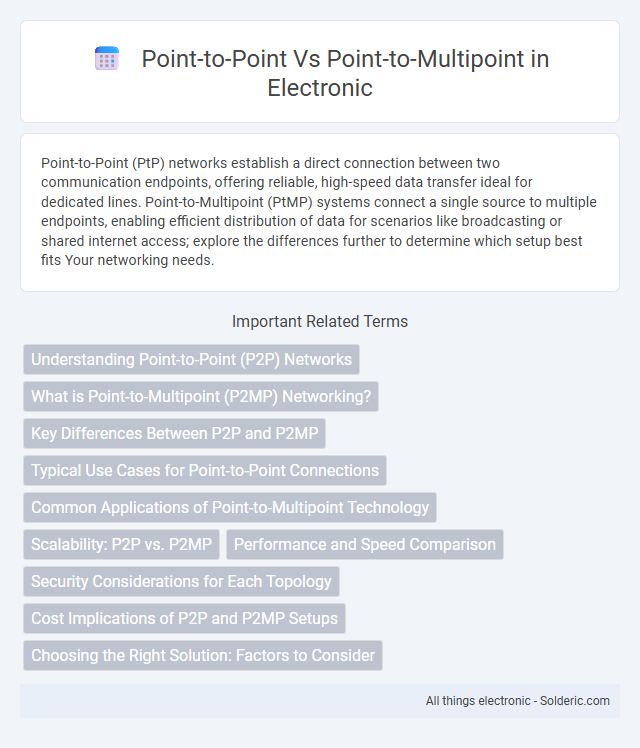Point-to-Point (PtP) networks establish a direct connection between two communication endpoints, offering reliable, high-speed data transfer ideal for dedicated lines. Point-to-Multipoint (PtMP) systems connect a single source to multiple endpoints, enabling efficient distribution of data for scenarios like broadcasting or shared internet access; explore the differences further to determine which setup best fits Your networking needs.
Comparison Table
| Feature | Point-to-Point (P2P) | Point-to-Multipoint (P2MP) |
|---|---|---|
| Definition | Direct connection between two nodes. | One central node connected to multiple nodes. |
| Network Topology | Dedicated link, one-to-one. | Shared medium, one-to-many. |
| Use Cases | High-bandwidth, secure links, e.g., leased lines. | Broadcast, distribution networks, wireless access points. |
| Bandwidth | Full bandwidth dedicated to two endpoints. | Bandwidth shared among multiple endpoints. |
| Cost | Higher due to dedicated infrastructure. | Cost-effective for connecting many devices. |
| Complexity | Simple routing and management. | More complex due to multiple endpoints. |
| Security | Higher security, direct link. | Lower security, shared access. |
Understanding Point-to-Point (P2P) Networks
Point-to-Point (P2P) networks establish a direct communication link between two devices, enabling dedicated bandwidth and low latency ideal for high-speed data transfer. These networks are commonly used in telecommunications, such as leased lines and fiber optic connections, ensuring secure and consistent data flow. Unlike Point-to-Multipoint systems, P2P networks offer enhanced performance due to exclusive channel allocation without sharing resources among multiple endpoints.
What is Point-to-Multipoint (P2MP) Networking?
Point-to-Multipoint (P2MP) networking connects a single central node to multiple endpoints, enabling efficient data distribution across a network. This architecture is commonly used in wireless communications, such as in broadband internet or cellular networks, where one base station serves many clients simultaneously. Understanding P2MP can help you optimize your network for scalability and resource management compared to Point-to-Point configurations.
Key Differences Between P2P and P2MP
Point-to-Point (P2P) networks establish a direct connection between two devices, ensuring dedicated bandwidth and low latency, ideal for secure, high-speed data transfers. Point-to-Multipoint (P2MP) networks connect one central device to multiple endpoints, optimizing resource sharing and reducing infrastructure costs, but with shared bandwidth that can impact performance. Understanding these key differences helps you choose the right network architecture based on your scalability needs and data transmission priorities.
Typical Use Cases for Point-to-Point Connections
Point-to-point connections are commonly used for dedicated, high-speed communication links between two locations, ideal for private network backhauls, secure data transfers, and connecting branch offices to a central hub. These connections provide a direct and reliable pathway, minimizing latency and interference, which is critical for applications like video conferencing, real-time data replication, and transaction processing. Your network benefits from enhanced security and consistent bandwidth, making point-to-point ideal for scenarios demanding guaranteed performance and minimal downtime.
Common Applications of Point-to-Multipoint Technology
Point-to-Multipoint technology is widely used in broadband internet distribution, enabling service providers to deliver high-speed connectivity to multiple customer locations from a central hub. It is also prevalent in wireless local area networks (WLANs) and surveillance systems, where several endpoints require simultaneous communication with a single access point. Industrial automation and smart grid applications leverage Point-to-Multipoint to efficiently monitor and control multiple devices across expansive areas.
Scalability: P2P vs. P2MP
Point-to-Point (P2P) networks offer direct, dedicated connections between two nodes, providing high performance but limited scalability due to the need for additional links as more devices join. Point-to-Multipoint (P2MP) architectures enable a single central node to communicate with multiple endpoints simultaneously, making them highly scalable and cost-effective for expanding networks. Your choice between P2P and P2MP affects network growth flexibility and resource allocation efficiency.
Performance and Speed Comparison
Point-to-Point (PtP) connections generally offer higher performance and faster speeds by providing a dedicated link between two locations, minimizing interference and maximizing bandwidth. Point-to-Multipoint (PtMP) systems share bandwidth among multiple users, which can reduce individual speeds and increase latency during peak usage times. Your network requirements should guide the choice, prioritizing PtP for critical, high-speed applications and PtMP for cost-effective coverage over wider areas.
Security Considerations for Each Topology
Point-to-point topology offers enhanced security by creating a direct, dedicated communication link between two devices, reducing the risk of data interception. In contrast, point-to-multipoint topology involves multiple nodes sharing a communication channel, which increases vulnerability to unauthorized access and requires stronger encryption and authentication protocols. Proper implementation of secure key management and network segmentation is critical to safeguarding both topologies against cyber threats.
Cost Implications of P2P and P2MP Setups
Point-to-Point (P2P) setups often incur higher initial costs due to dedicated hardware and direct line-of-sight requirements, making them ideal for high-capacity, long-distance links with minimal interference. Point-to-Multipoint (P2MP) configurations reduce overall expenses by enabling a single central node to communicate with multiple endpoints, lowering infrastructure and maintenance costs significantly. Your choice between P2P and P2MP impacts cost efficiency depending on network scale and traffic patterns, with P2MP generally providing better cost-effectiveness for widespread, multi-location connectivity.
Choosing the Right Solution: Factors to Consider
Selecting between Point-to-Point (PtP) and Point-to-Multipoint (PtMP) wireless communication depends on factors such as distance, bandwidth requirements, and the number of endpoints. PtP solutions offer dedicated, high-capacity links ideal for connecting two fixed locations over long distances with minimal interference. In contrast, PtMP systems efficiently serve multiple endpoints from a central hub, optimizing cost and scalability for local access networks but may have lower individual link quality compared to PtP.
Point-to-Point vs Point-to-Multipoint Infographic

 solderic.com
solderic.com